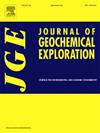A new supervised learning framework for mineral prospectivity mapping: The three-class labeling (3CL) approach
IF 3.3
2区 地球科学
Q1 GEOCHEMISTRY & GEOPHYSICS
引用次数: 0
Abstract
Mineral exploration depends on the ability to accurately distinguish geological characteristics and predict mineralization zones. This study introduces a novel three-class labeling (3CL) strategy, which categorizes regions as mineralized, non-mineralized, and neutral. Compared to traditional two-class labeling (2CL), this approach reduces false positives and enhances prediction precision by capturing intermediate areas that do not fit clearly into mineralized or non-mineralized categories. To implement this approach, we employed the Random Forest method to model mineralization potential, training it with optimized hyperparameters using GridSearchCV. The optimized trained model evaluation metrics demonstrated that the 3CL model outperformed the 2CL one, with higher accuracy (98 % vs. 96 %), F1-score (0.98 vs. 0.96), and Kappa coefficient (0.97 vs. 0.92), confirming its superior capability in distinguishing prospective zones while reducing misclassification. The 3CL approach enhances the spatial precision of prediction maps and offers a more geologically realistic interpretation of mineralization potential. These findings highlight the practical advantages of 3CL in improving exploration efficiency and guiding decision-making for resource allocation in mineral prospectivity studies.
一种新的有监督学习框架:三类标记(3CL)方法
找矿取决于准确区分地质特征和预测成矿带的能力。本研究引入了一种新的三级标记(3CL)策略,将区域划分为矿化、非矿化和中性。与传统的两类标记(2CL)相比,该方法通过捕获不明显适合矿化或非矿化类别的中间区域来减少误报并提高预测精度。为了实现这一方法,我们采用随机森林方法对矿化势进行建模,并使用GridSearchCV对其进行优化的超参数训练。优化后的训练模型评价指标表明,3CL模型优于2CL模型,具有更高的准确率(98%对96%)、f1评分(0.98对0.96)和Kappa系数(0.97对0.92),证实了其在识别勘探层和减少误分类方面的优势。3CL方法提高了预测图的空间精度,并提供了更符合地质实际的矿化潜力解释。这些发现凸显了3CL在矿产找矿研究中提高勘探效率和指导资源配置决策方面的实际优势。
本文章由计算机程序翻译,如有差异,请以英文原文为准。
求助全文
约1分钟内获得全文
求助全文
来源期刊

Journal of Geochemical Exploration
地学-地球化学与地球物理
CiteScore
7.40
自引率
7.70%
发文量
148
审稿时长
8.1 months
期刊介绍:
Journal of Geochemical Exploration is mostly dedicated to publication of original studies in exploration and environmental geochemistry and related topics.
Contributions considered of prevalent interest for the journal include researches based on the application of innovative methods to:
define the genesis and the evolution of mineral deposits including transfer of elements in large-scale mineralized areas.
analyze complex systems at the boundaries between bio-geochemistry, metal transport and mineral accumulation.
evaluate effects of historical mining activities on the surface environment.
trace pollutant sources and define their fate and transport models in the near-surface and surface environments involving solid, fluid and aerial matrices.
assess and quantify natural and technogenic radioactivity in the environment.
determine geochemical anomalies and set baseline reference values using compositional data analysis, multivariate statistics and geo-spatial analysis.
assess the impacts of anthropogenic contamination on ecosystems and human health at local and regional scale to prioritize and classify risks through deterministic and stochastic approaches.
Papers dedicated to the presentation of newly developed methods in analytical geochemistry to be applied in the field or in laboratory are also within the topics of interest for the journal.
 求助内容:
求助内容: 应助结果提醒方式:
应助结果提醒方式:


